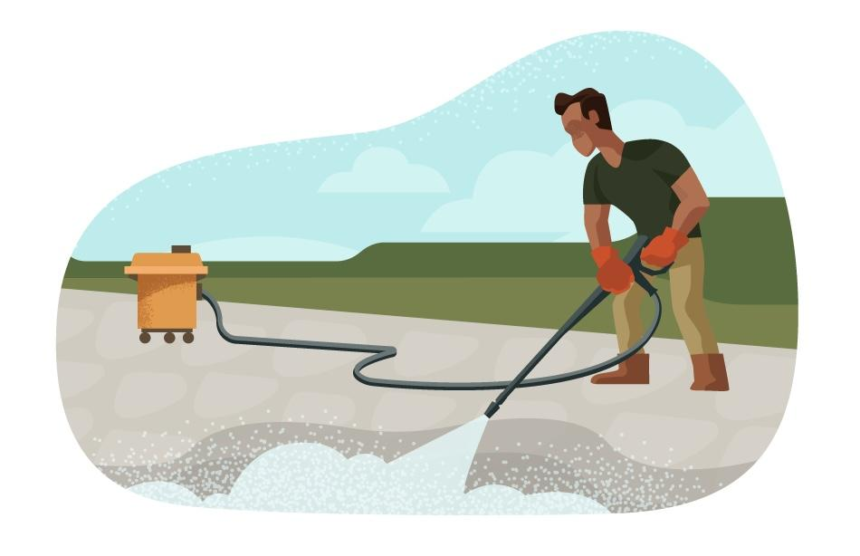Pressure washing is an exceptionally successful strategy for cleaning different surfaces, from carports and walkways to building exteriors and outdoor equipment. Mold, grime, and other contaminants are removed by utilizing a powerful stream of water. While pressure washing has the potential to produce exceptional outcomes, it is essential to place safety first during the cleaning process. In this article, we will discuss the most important safety considerations and recommended procedures for pressure washing.
Safety Considerations When Carrying Out Pressure Washing
Personal Protective Equipment (PPE)
Personal Protective Equipment (PPE) is one of the first and most important safety considerations when pressure washing. This includes protective gear like gloves, safety goggles, or a face shield. Gloves shield the hands from the high-pressure water stream and chemicals, while safety goggles or a face shield protects the eyes from flying debris and water splashes. Wearing legitimate apparel, for example, long-sleeved shirts and jeans, assists with safeguarding the skin from possible wounds and chemical exposure.
Proper Training and Knowledge
Before using a pressure washer, it’s important to have the right training and know-how. To ensure safe and efficient cleaning, it is essential to comprehend the equipment, its components, and its operating procedures. Pressure washer operation, nozzle selection, keeping a safe distance from surfaces, and recognizing potential hazards should all be covered in training. Individuals can handle pressure washing equipment with confidence and safety if they have the necessary knowledge and training.
Choosing the Right Pressure and Nozzle
Choosing the appropriate pressure level and nozzle for a particular cleaning task is essential to ensuring safety and preventing damage to surfaces. The level of pressure required by various surfaces varies, and applying too much pressure can be harmful. Start with the lowest pressure setting and gradually increase it as necessary, taking care not to go over the manufacturer’s maximum pressure limits. In a similar vein, selecting the appropriate nozzle, such as a wide-angle nozzle for cleaning large areas or a narrow-angle nozzle for cleaning smaller areas more precisely, aids in controlling the flow of water and prevents unnecessary risks.
Maintaining Safe Distance
It is essential to maintain a safe distance between the pressure washer nozzle and the surface being cleaned. Getting too close to the surface can cause cuts, injuries, or effect wounds because of the high-pressure water stream. It is suggested that you maintain a distance from the surface of at least one to two feet and gradually move closer if necessary, always being cautious and mindful of any potential dangers or fragile areas.

Precautions to Avoid Electrical Dangers
Since pressure washers are typically powered by electricity, it is essential to take measures to prevent electrical dangers. Make sure the power cord is properly grounded and kept out of water. Before using the cord, check for signs of damage and don’t use extension cords unless absolutely necessary. If an extension cord is necessary, check to see that it is suitable for outdoor use and has the appropriate power meter for the equipment.
Chemical Safety – Protecting Your Skin
During pressure washing, cleaning chemicals are frequently utilized to enhance the cleaning process. It is fundamental to adhere to the producer’s directions and rules while taking care of and applying these synthetic compounds. This includes wearing the right PPE, using the right dilution ratios, and not touching the skin or eyes directly. In addition, it is essential to take into account the effects that the chemicals have on the environment and to make use of biodegradable and eco-friendly options whenever possible.
Safety Surface Precautions To Adhere to
During pressure washing, various surfaces may necessitate particular precautions. Lower pressure settings, gentle cleaning agents, or additional safeguards may be required for delicate surfaces like painted surfaces, wood, or fragile materials. Before beginning the cleaning process, it is crucial to assess the surface’s condition and vulnerability to damage. By taking the necessary precautions, unintended damage can be avoided and effective cleaning can be achieved without jeopardizing safety.
Opt For Professional Services
In complex or large-scale pressure washing projects, it is often best to engage professional commercial cleaners. A wide range of cleaning jobs can be handled safely and effectively by professional pressure washing companies thanks to their knowledge, equipment, and experience. They are able to effectively assess and deal with potential hazards, have access to specialized tools, and comprehend the safety protocols. In addition to guaranteeing the best cleaning results, hiring professionals also lowers the likelihood of injuries and accidents.
Conclusion
When performing pressure washing tasks, ensuring one’s safety should be of the utmost importance. . By following these best practices, including using appropriate personal protective equipment, acquiring proper training, choosing the correct pressure and nozzle, maintaining a safe distance, and being mindful of electrical hazards and chemical safety, individuals can ensure effective cleaning while safeguarding themselves and the surfaces being cleaned. Always seek professional pressure washing services when in doubt to ensure safety and the best possible results.

